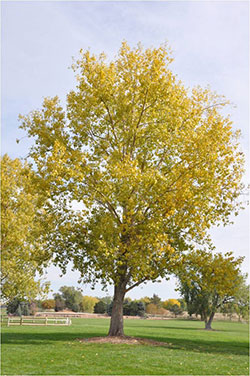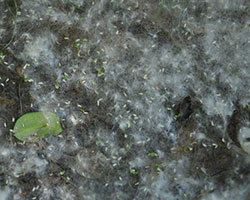
When do cottonwoods shed cotton?
Cottonwood trees are dioecious, meaning they have male and female flowers on separate trees. Cotton shed by female trees in June is often so abundant that it turns nearby lawns white. Heavy snows in winter promote plentiful new growth. This in turn fuels abundant flowering of both male (“cotton less”) and female (“cotton-bearing”) cottonwoods in the spring. Flowers on female trees, after being pollinated by wind-borne pollen from male trees in April, develop small green capsules that split open in June to shed small seeds carried by wind-borne “cotton”.
How long does a cottonwood take to mature?
It takes cottonwood seedlings several years of growth to become sexually mature and flower. This explains the observation for a female tree that “it never had cotton for years after the seedling came up. Now it has cotton every year”.
Are cottonwoods accepted everywhere?
 Some municipalities have ordinances against female cottonwood trees, as the wind-blown cotton is deemed a nuisance. A few municipalities enact ordinances againstmale (“cotton less”) cottonwoods, because the April pollen causes problems for allergy sufferers. Although cotton can be a nuisance, it has no allergenic properties. People with allergy symptoms during June cotton distribution are probably suffering from other wind-borne pollen – from grasses, weeds or other trees.
Some municipalities have ordinances against female cottonwood trees, as the wind-blown cotton is deemed a nuisance. A few municipalities enact ordinances againstmale (“cotton less”) cottonwoods, because the April pollen causes problems for allergy sufferers. Although cotton can be a nuisance, it has no allergenic properties. People with allergy symptoms during June cotton distribution are probably suffering from other wind-borne pollen – from grasses, weeds or other trees.

A few cases of nursery-sold “cotton less” cottonwoods later developing cotton are usually due to mislabeling or to a misunderstanding. Some hybrid cottonwoods sold in the nursery trade are listed as “sterile female hybrids”. These are not “cottonless” because they are not male. “Sterile” in this case refers to the fact that they bear inviable seed, incapable of germinating but still produce much cotton to distribute that inviable seed.
Ethephon, sold as FlorelT, is labeled to prevent cotton development in female trees and needs to be applied during flower development.



